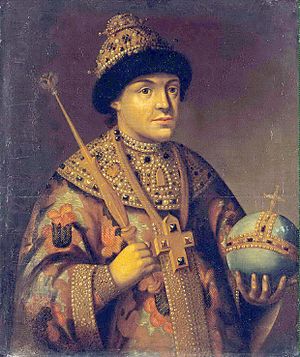Feodor III of Russia facts for kids
Quick facts for kids Feodor III |
|||||
|---|---|---|---|---|---|
 |
|||||
| Tsar of Russia | |||||
| Reign | 8 February (29 January O.S.) 1676 – 7 May 1682 | ||||
| Coronation | 18 June 1676 | ||||
| Predecessor | Alexis | ||||
| Successor | Peter I and Ivan V | ||||
| Born | 9 June 1661 Moscow |
||||
| Died | 7 May 1682 (aged 20) Moscow |
||||
| Burial | Archangel Cathedral | ||||
| Consort |
Agafiya Semyonovna Grushetskaya
(m. 1680; died 1681)Marfa Apraxina
(m. 1682) |
||||
|
|||||
| House | Romanov | ||||
| Father | Alexis I | ||||
| Mother | Maria Ilyinichna Miloslavskaya | ||||
| Religion | Eastern Orthodox | ||||
Feodor III Alexeyevich (in Russian: Фёдор III Алексеевич) or Fyodor III Alekseevich was born on June 9, 1661, and died on May 7, 1682. He was the Tsar of Russia from 1676 to 1682. A Tsar was like a king or emperor in Russia.
Contents
Life as Tsar
Feodor was born in Moscow. He was the oldest living son of Tsar Alexis and Maria Miloslavskaya. When his father died in 1676, Feodor became Tsar at the age of fifteen.
He was a very smart person and had a kind nature. He received an excellent education from Simeon Polotsky, who was a very wise monk. Feodor knew Polish and even Latin, which was unusual for a Russian ruler at that time.
From birth, Feodor had a mysterious illness, possibly scurvy, which left him partly paralyzed and disfigured. Despite his health problems, he was a dedicated reformer. He spent a lot of time with young nobles like Ivan Maksimovich Yazykov and Aleksei Timofeievich Likhachov. These friends later helped bring Polish customs, clothing, and language to the Russian court.
On July 28, 1680, Feodor married a noblewoman named Agaphia Simeonovna Grushevskaya. Even with his health issues, Feodor was full of energy and eager to make changes. His rule brought a more open atmosphere to the court. He also made the laws less harsh.
Feodor founded an academy of sciences in the Zaikonospassky monastery. Here, smart teachers taught many subjects. These included Slavonic, Greek, Latin, and Polish. They taught everything that was not forbidden by the Orthodox Church.
One of Feodor III's most important changes happened in 1682. He ended the system of mestnichestvo, or "place priority." This old system had made it hard for the government and military to work well for many years. It meant that a person's family background, not their skills, decided their job.
Thanks to Feodor's reform, suggested by Vasily Galitzine, people were now chosen for government and military jobs based on their skills and the Tsar's decision. All the old books that listed family importance were destroyed.
Family Life
Feodor's first wife, Agaphia Simeonovna Grushevskaya, shared his ideas about progress. She was even the first to suggest that men should shave their beards.
On July 11, 1681, Tsaritsa Agaphia gave birth to their son, Tsarevich Ilya Fyodorovich. He was the expected heir to the throne. Sadly, Agaphia died three days later, on July 14, due to complications from childbirth. Just seven days after that, on July 21, their ten-day-old son also passed away.
Seven months later, on February 24, 1682, Feodor married for a second time. His new wife was Marfa Apraksina (1667–1716). Feodor died three months after this wedding, on May 7, 1682. He did not have any children who survived him. The news of his death led to the Moscow Uprising of 1682.
Images for kids
See also
 In Spanish: Teodoro III de Rusia para niños
In Spanish: Teodoro III de Rusia para niños


